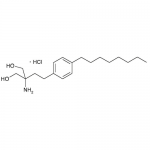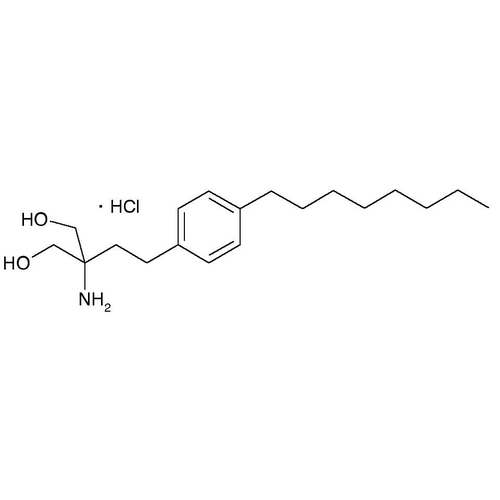| Product Name | Fingolimod (FTY720 Hydrochloride) |
| Description |
S1P Receptor Modulator |
| Purity | >98% (TLC); NMR (Conforms) |
| CAS No. | 162359-56-0 |
| Molecular Formula | C19H34ClNO2 |
| Molecular Weight | 343.9 |
| Field of Use | Not for use in humans. Not for use in diagnostics or therapeutics. For in vitro research use only. |
Properties
| Storage Temperature | -20ºC |
| Shipping Temperature | Shipped Ambient |
| Product Type | Agonist |
| Solubility | Soluble to 100 mg/ml in DMSO or to 40 mg/ml in ethanol (warmed) |
| Source | Synthetic |
| Appearance | White solid |
| SMILES | CCCCCCCCC1=CC=C(C=C1)CCC(CO)(CO)N.Cl |
| InChI | InChI=1S/C19H33NO2.ClH/c1-2-3-4-5-6-7-8-17-9-11-18(12-10-17)13-14-19(20,15-21)16-22;/h9-12,21-22H,2-8,13-16,20H2,1H3;1H |
| InChIKey | SWZTYAVBMYWFGS-UHFFFAOYSA-N |
| Safety Phrases |
Classification: D2B Toxic Material Causing Other Toxic Effects Moderate skin irritant Moderate eye irritant Safety Phrases: S22 - Do not breathe dust. S24/25 - Avoid contact with skin and eyes. S36/37/39 - Wear suitable protective clothing, gloves and eye/face protection. Hazard statement(s): H315 Causes skin irritation. H319 Causes serious eye irritation. H335 May cause respiratory irritation. H412 Harmful to aquatic life with long lasting effects. Precautionary statement(s): P261 Avoid breathing dust/ fume/ gas/ mist/ vapours/ spray. P273 Avoid release to the environment. P305 + P351 + P338 IF IN EYES: Rinse cautiously with water for several minutes. Remove contact lenses, if present and easy to do. Continue rinsing. |
| Cite This Product | FTY720 Hydrochloride (StressMarq Biosciences, Canada, Cat # SIH-523) |
Biological Description
| Alternative Names | 2-Amino-2-[2-(4-octylphenyl)ethyl]-1,3-propanediol,hydrochloride; Fingolimod |
| Research Areas | Cell Signaling, Neurodegeneration, Neuroscience, Parkinson's Disease |
| PubChem ID | 107969 |
| Scientific Background | FTY720 Hydrochloride, also known as fingolimod, is a potent modulator of sphingosine 1-phosphate (S1P) receptors. Upon phosphorylation by sphingosine kinase, it binds to S1P receptors, sequestering lymphocytes in lymph nodes and reducing neuroinflammation. This mechanism underpins its clinical use in multiple sclerosis. In neuroscience, FTY720 has demonstrated the ability to stimulate neuronal gene expression, promote axonal growth, and support regeneration. Recent studies also highlight its potential to reduce α-synuclein pathology in Parkinson’s disease models, making it a promising candidate for neurodegenerative disease research. |
| References |
1. Wolf A., et al. (2009) J Immunol. 183(6): 3751-60. 2. Brinkmann V., et al. (2002) J Biol Chem. 277(24): 21453-7. 3. Anastasiadou S., and Knoll B. (2016) Exp. Neurol. 279: 243-260. 4. Vidal-Martinez G., at al. (2019) Neuroscience. 411: 1-10. |



Reviews
There are no reviews yet.